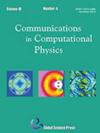针对非结构网格采用新的单元界面流量评估策略的有限体积 TENO 方案
IF 3.1
3区 物理与天体物理
Q1 PHYSICS, MATHEMATICAL
引用次数: 0
摘要
开发高阶冲击捕获方案对于可压缩流体模拟至关重要,尤其是在同时存在冲击波和小尺度湍流结构的情况下。作为最先进的高阶数值方案之一,Fu 等人提出的高阶目标 ENO(TENO)方案系列[《计算物理学报》305 (2016): 3-37] [Journal.Computing Physics 305 (2016: 3-37]] 是目前最先进的高阶数值方案。[Journal of Computational Physics 305 (2016): 333-359]提出的高阶目标ENO(TENO)方案族在结构网格的可压缩气体动力学中表现良好,最近Ji等人[Journal of Scientific Computing 92(2022):1-39]将其扩展到非结构网格。在本文中,我们观察到 TENO 方案不仅能提供单元界面的高阶重建数据,而且还具有在波数空间中分离局部流动尺度的潜力,因此我们提出了一种低耗散有限体积 TENO 方案,并为非结构网格提出了一种新的单元界面通量评估策略。该方案的新颖之处在于,在重建过程中对局部流尺度进行强尺度分离后,将其划分为 "非常平滑 "或 "不平滑"。当目标细胞界面的相应大型中心偏置模版被判定为 "非常平滑 "时,细胞界面流量计算将采用低耗散黎曼求解器,即非耗散中心流量方案。否则,采用耗散近似黎曼求解器,以避免虚假振荡,实现稳定的冲击捕捉。这种策略在一个统一的框架内对高阶重构过程和细胞界面通量计算的数值耗散进行了单独控制,从而产生了一种具有极低耗散特性和良好数值稳健性的有限体积方法。在不逐个调整参数的情况下,进行了一组典型基准模拟,以评估所提出方案的性能。本文章由计算机程序翻译,如有差异,请以英文原文为准。
Finite-Volume TENO Scheme with a New Cell-Interface Flux Evaluation Strategy for Unstructured Meshes
The development of high-order shock-capturing schemes is critical for compressible fluid simulations, in particular for cases where both shock waves and small-scale turbulence structures present. As one of the state-of-the-art high-order numerical
schemes, the family of high-order targeted ENO (TENO) schemes proposed by Fu et
al. [Journal of Computational Physics 305 (2016): 333-359] has been demonstrated to
perform well for compressible gas dynamics on structured meshes and recently extended to unstructured meshes by Ji et al. [Journal of Scientific Computing 92(2022):
1-39]. In this paper, with the observation that the TENO scheme not only provides
the high-order reconstructed data at the cell interface but also features the potential to
separate the local flow scales in the wavenumber space, we propose a low-dissipation
finite-volume TENO scheme with a new cell-interface flux evaluation strategy for unstructured meshes. The novelty originates from the fact that the local flow scales are
classified, following a strong scale separation in the reconstruction process, as “very
smooth” or not. When the corresponding large central-biased stencil for the targeted
cell interface is judged to be “very smooth”, a low-dissipation Riemann solver, even
the non-dissipative central flux scheme, is employed for the cell-interface flux computing. Otherwise, a dissipative approximate Riemann solver is employed to avoid spurious oscillations and achieve stable shock-capturing. Such a strategy provides separate
control over the numerical dissipation of the high-order reconstruction process and
the cell-interface flux calculation within a unified framework and leads to a resultant
finite-volume method with extremely low-dissipation properties and good numerical
robustness. Without parameter tuning case by case, a set of canonical benchmark simulations has been conducted to assess the performance of the proposed scheme.
求助全文
通过发布文献求助,成功后即可免费获取论文全文。
去求助
来源期刊

Communications in Computational Physics
物理-物理:数学物理
CiteScore
4.70
自引率
5.40%
发文量
84
审稿时长
9 months
期刊介绍:
Communications in Computational Physics (CiCP) publishes original research and survey papers of high scientific value in computational modeling of physical problems. Results in multi-physics and multi-scale innovative computational methods and modeling in all physical sciences will be featured.
 求助内容:
求助内容: 应助结果提醒方式:
应助结果提醒方式:


